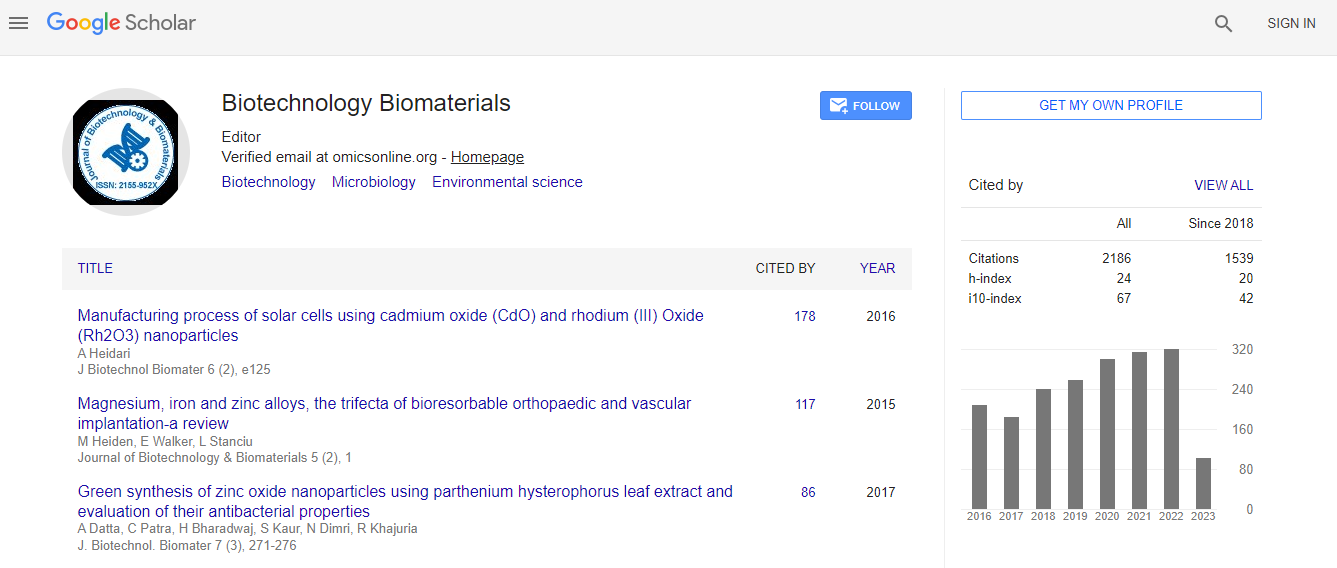Our Group organises 3000+ Global Conferenceseries Events every year across USA, Europe & Asia with support from 1000 more scientific Societies and Publishes 700+ Open Access Journals which contains over 50000 eminent personalities, reputed scientists as editorial board members.
Open Access Journals gaining more Readers and Citations
700 Journals and 15,000,000 Readers Each Journal is getting 25,000+ Readers
Google Scholar citation report
Citations : 3330
Journal of Biotechnology & Biomaterials received 3330 citations as per Google Scholar report
Indexed In
- Index Copernicus
- Google Scholar
- Sherpa Romeo
- Open J Gate
- Genamics JournalSeek
- Academic Keys
- ResearchBible
- China National Knowledge Infrastructure (CNKI)
- Access to Global Online Research in Agriculture (AGORA)
- Electronic Journals Library
- RefSeek
- Hamdard University
- EBSCO A-Z
- OCLC- WorldCat
- SWB online catalog
- Virtual Library of Biology (vifabio)
- Publons
- Geneva Foundation for Medical Education and Research
- Euro Pub
- ICMJE
Useful Links
Recommended Journals
Related Subjects
Share This Page
Gender identification in dioecious Populus ciliata using molecular and morphological markers
6th World Congress on Biotechnology
Amita Kumari and Prem Kumar Khosla
Shoolini University, India
Posters-Accepted Abstracts: J Biotechnol Biomater
Abstract
Gender in a dioecious tree species is generally identified at reproductive phase. In case nursery growers are able to know the gender at early stage of growth (seedling stage) it will be economically beneficial. The present investigations are undertaken verifying this fact in view and Populus ciliata was taken as first plant. It is hypothesized that in plants where the sex chromosomes are not identified, there may be a region in the genome or DNA of the tree which may influence the gender of the plant. RAPD markers were used as a tool of study along with variation in leaf morphological characters between male and female mature trees. Out of ten polymorphic random primers used, one primer (OPK-20) gave significant difference between male and female trees and identified as female specific marker (OPK-20400, OPK-20500 and OPK-20800). This marker is distinct to determine the sex of P. ciliata at an early stage. The qualitative traits (i.e., shape of base and tip of leaf blade, sinus with petiole, pubescence on the lower surface of the leaf blade, leaf margin and colour of the blade) and quantitative traits (i.e., LA, L/W%, P/N%, perimeter, aspect ratio and shape factor) in male and female tree showed that three qualitative characters (shape of base of leaf blade, sinus with petiole and leaf margin) were distinct in male and female trees. The quantitative parameters, except the shape factor showed non-significant differences. It is concluded that qualitative differences exists between the two genders in P. ciliata besides the specific marker.Biography
Email: amitabot@gmail.com

 Spanish
Spanish  Chinese
Chinese  Russian
Russian  German
German  French
French  Japanese
Japanese  Portuguese
Portuguese  Hindi
Hindi 
